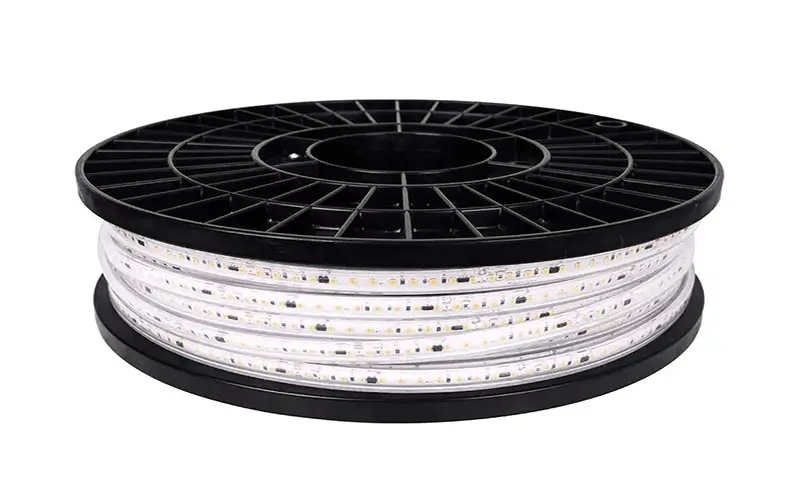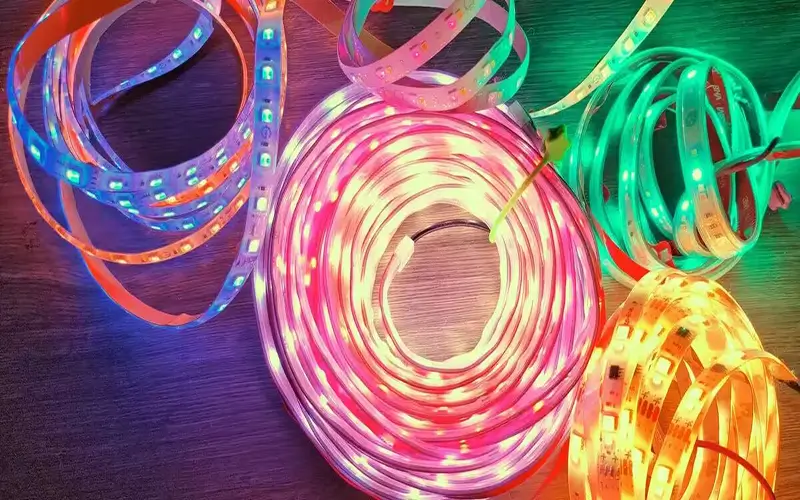
LED strip lights are increasingly gaining popularity in residential and commercial lighting applications due to their versatility and ease of installation. When it comes to LED strip lights, we need to divide them into high-voltage LED strip lights vs low-voltage LED strip lights according to different usage occasions and different requirements for LED strip lights.
In this article, we will explore the difference between high-voltage LED strip lights vs low-voltage LED strip lights, and analyze the installation scenarios of high-voltage LED strip lights vs low-voltage LED strip lights, etc.
What Is a High-voltage LED Strip Lights?
High-voltage LED strip lights typically run on 110V or 220V power. It is the standard voltage for household use. These high-voltage strips typically require direct wiring to a circuit, making them ideal for professional installations or applications where lighting spans a large area.

What Is a Low-voltage LED Strip Lights?
Low-voltage LED strips are usually DC12V or DC24V, and their working voltage is much lower. We think the design of these low-voltage LED strip lights is more user-friendly. Homeowners can easily install it without extensive electrical knowledge since it supports safe installation within limits.
Low-voltage LED strip lights usually come with a power adapter or transformer that converts the voltage from a standard electrical outlet.

High-voltage LED Strip Lights vs Low-voltage LED Strip Lights:
High-voltage vs low voltage LED strips are the power supply and installation requirements. Let’s analyze their differences in the points below.
Safety
The 220V voltage used by high-voltage LED strip lights is not a safe voltage. There are potential safety hazards in some risky applications; while low-voltage LED strip lights work under the working voltage of DC 12V or 24V, which is a safe voltage. There is no danger to the person.
Cost
If you only look at the price of the strip light, the prices of the two LED strip lights are similar. However, there is a difference in terms of overall cost. High-voltage LED strip lights come equipped with a high-voltage power supply, allowing them to support 30-50-meter LED strip lights simultaneously. Therefore, the overall cost of high-voltage LED strip lights is relatively low.
Installation
Installing high-voltage LED strip lights is straightforward as they can be directly powered by a high-voltage driver. They come pre-equipped and function properly when connected to a 220V power supply.
Low-voltage LED strip lights require connecting a DC power supply to a 220V power source, making the installation relatively more complex.
Packaging
The packaging of high-voltage LED strip lights is also very different from that of low-voltage LED strip lights. High-voltage LED flexible light strips can generally be 50-100 meters per roll; low-voltage LED strip lights can generally be up to 5-10 meters per roll; DC power supply attenuation beyond 10 meters will be severe.
Lifetime
The service life of low-voltage LED strip lights can reach 30,000-50,000 hours. High-voltage LED strip lights have a direct impact on the life of high-voltage LED strip lights because of their high voltage.
Generally speaking, the service life of high-voltage is about 10,000 hours. Therefore, the life of the light bar with low voltage will be much longer than that of high voltage.
The above analysis reveals that high and low-voltage LED strip lights possess their own advantages and disadvantages. You can choose the right product according to your project.
Where Are the High-voltage LED Strip Lights Used?
High Voltage LED strip lights are ideal for larger lighting projects where projects require longer lengths and higher brightness levels. Commonly used for architectural lighting, commercial signage, outdoor building facades, and stadium lighting. Because higher voltages can provide greater illumination while ensuring consistent brightness over longer distances.
Where Are Low-voltage LED Strip Lights Used?
Low-voltage LED strip lights offer great versatility and find applications in various lighting projects, including residential environments and architectural lighting. Primarily for ambient lighting, task lighting, or decorative purposes.
If used for residential lighting. It is commonly installed under kitchen cupboards, along staircases, in bedrooms, or in entertainment areas where a softer and more intimate lighting effect is desired.
If used for architectural lighting. It is frequently used on ceilings, walls, corridors, exterior walls, etc., primarily in conjunction with other lighting solutions.

Which is More Durable, Low-voltage LED Strip Lights vs High-voltage LED Strip Lights?
We carefully design and test both low-voltage and high-voltage LED strips. Both are durable, long-lasting, and energy-efficient. But low voltage LED strips tend to be more resilient to voltage fluctuations or surges in comparison.
The lower operating voltage provides an extra layer of protection against electrical problems, making it less prone to damage. Additionally, low-voltage LED strips often come with a built-in voltage regulator or surge protector to further enhance their durability.
Low-voltage LED Strip Lights vs High-voltage LED Strip Lights, How to Choose?
You may be facing this problem, how to choose the right low-voltage vs high-voltage LED strip lights, please consider the following factors:
Lighting Project Scale
Determine the scale of the lighting project. High-voltage LED strip lights are more suitable for large installations, commercial or architectural projects with longer continuous lighting time. Low-voltage LED strip lights are more versatile, and which easily adapt for interior and architectural lighting.
Safety Considerations
Definitely a priority. Low-voltage LED strip lights operate on a lower voltage (usually 12V or 24V). If direct contact is required, it would be better for you to choose a low-voltage LED strip. Also, if you need to install in areas or wet environments, the low-pressure option is a better choice. High-voltage LED strip lights (110V or 220V) require additional safety measures and specialized installation expertise.
Durability
Consider the quality and durability of your LED strip lights. Need to look for a reputable brand or manufacturer that offers high-quality products. Have features like good cooling, high-quality components, and a warranty. This ensures a longer lifespan and consistent performance.
Energy Efficiency
Calculate required energy consumption. LED technology is known for its energy-saving benefits, but different LED strips can vary in efficiency. You need to find energy-efficient LED strip lights to ensure optimal energy efficiency and brightness.
Pressure Drops Concerns
Consider the length of the lighting run. High-voltage LED strip lights can run continuously for long periods of time without significant voltage drops. If your project requires long-distance lighting, then you’re best off with a high-voltage option for consistent brightness. Low-voltage LED strips may experience a voltage drop over a long distance, affecting lighting quality.
Color Temperature and Color
To confirm the color temperature you need. The LED strip lights are available in a variety of color temperatures, from warm white to cool white, as well as RGB color-changing options. Choose the color temperature and color options that best suit your desired ambience and lighting effect.
Ease of installation
Consider how you will install it. Low-voltage LED strips are usually easier to install and operate yourself. They usually come with relevant connectors and adhesive backing, so you can install them directly. However, high-voltage LED strips require more expertise from an electrician to properly wire and install.
By considering these factors, you can choose the appropriate low-voltage LED strip light vs high-voltage LED light strip that meets your specific project requirements, installation capabilities, safety concerns, and lighting preferences.
Summary
In short, whether you choose high-voltage LED strip lights vs low-voltage LED strip lights, all depends on your specific lighting needs and project requirements.
High-voltage light strips are more suitable for commercial or large-scale applications. With higher brightness and longer continuous running time requirements. Low-voltage LED strip lights are more versatile and easier to install. Making them ideal for residential or small projects where customization and safety are key. We are a LED neon flex manufacturer. If you have any questions, please consult us.
FAQs
The main difference is power supply and installation requirements. The working voltage of the high-voltage LED strip is 110V or 220V, and the working voltage of the low-voltage LED strip is 12V or 24V.
Because low-voltage LED strips operate on low voltage, people generally consider them safer for direct contact.
We do not recommend installing high-voltage LED strips by yourself. Because the high voltage is 110V or 220V, it is no longer within the safe voltage range. We recommend consulting a professional electrician to install high-voltage LED strips.
You can indeed use low-voltage LED strip lights outdoors. However, make sure you choose the appropriate waterproof rating for outdoor use.
It is not recommended to cut high-voltage LED strips. Because they are continuous circuit work, snipping could present a shock hazard. On the other hand, low-voltage LED strips are designed with designated cutting points, allowing you to customize the length as needed.
